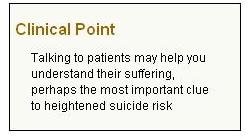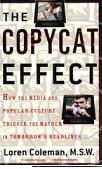Suicide
"What should I say/do to my son after this happened to him?"

Continue reading:
""What should I say/do to my son after this happened to him?"" ››

 Score: 112 (122 votes cast)
Score: 112 (122 votes cast)
The Suicide Of Bill Zeller

Continue reading:
"The Suicide Of Bill Zeller" ››

 Score: 47 (71 votes cast)
Score: 47 (71 votes cast)
How Not To Prevent Military Suicides
Rutgers Student Commits Suicide (After (Being Taped) (Having (Gay) Sex))?
 this could go either way
this could go either wayContinue reading:
"Rutgers Student Commits Suicide (After (Being Taped) (Having (Gay) Sex))?" ››

 Score: 42 (56 votes cast)
Score: 42 (56 votes cast)
Will The Suicide Rate Change As The Population Ages?
 The correct question would be: what will they do?
The correct question would be: what will they do?
Continue reading:
"Will The Suicide Rate Change As The Population Ages?" ››

 Score: 1 (3 votes cast)
Score: 1 (3 votes cast)
As The Population Ages, Will Suicides Increase?
Don't bet your life on it.
Continue reading:
"As The Population Ages, Will Suicides Increase?" ››

 Score: 1 (3 votes cast)
Score: 1 (3 votes cast)
Radio Host Has Drug Company Ties
Continue reading:
"Radio Host Has Drug Company Ties " ››

 Score: 1 (3 votes cast)
Score: 1 (3 votes cast)
How Dangerous Is Academic Psychiatry? Ask David Foster Wallace
Continue reading:
"How Dangerous Is Academic Psychiatry? Ask David Foster Wallace" ››

 Score: 4 (10 votes cast)
Score: 4 (10 votes cast)
Guess What Isn't The Cause Of Physician Suicide
Continue reading:
"Guess What Isn't The Cause Of Physician Suicide" ››

 Score: 3 (7 votes cast)
Score: 3 (7 votes cast)
Self-Embedding Syndrome: What's Going On In Ohio?

A poster presented at the Radiological Society Of North America. Self-embedding syndrome: adolescents embed foreign bodies into their arms, hands, etc. In this x-ray, she's embedded 8 pieces of metal into her arm.
What caught my eye were two things: first, even though this is an old problem, the authors say this is the first study on this, suggesting that it's on the rise (enough for radiologists to notice.) Second, that it happened in Ohio-- which was, along with Indiana, was responsible for half of the youth suicide increase in 2007.

 Score: -1 (3 votes cast)
Score: -1 (3 votes cast)
The FDA Says No Black Box Needed On Drugs That Increase Suicidality, But Still Needed For Those That Don't
Yes, you read that right. Drink a big glass of OJ and put away your blotter paper, you won't need 'em in here.
Continue reading:
"The FDA Says No Black Box Needed On Drugs That Increase Suicidality, But Still Needed For Those That Don't" ››

 Score: 0 (2 votes cast)
Score: 0 (2 votes cast)
Suicidal Patients' Access To Their Psychiatrist
Continue reading:
"Suicidal Patients' Access To Their Psychiatrist" ››

 Score: 0 (4 votes cast)
Score: 0 (4 votes cast)
What Else Causes Suicide? You'll Never Guess
 In which I take the semiotic logic of medication induced suicidality to its inevitable, silly end.
In which I take the semiotic logic of medication induced suicidality to its inevitable, silly end.Using nothing more than a Volvo. And without lawyers.
Continue reading:
"What Else Causes Suicide? You'll Never Guess" ››

 Score: 8 (12 votes cast)
Score: 8 (12 votes cast)
FDA Discovers That Anticonvulsants Cause Suicide, Too
You probably think this is an example of the new FDA, the new anti-Pharma FDA, more attentive to public health, getting their act and their data together for the benefit of Americans.
Ha. Wrong.
Continue reading:
"FDA Discovers That Anticonvulsants Cause Suicide, Too" ››

 Score: 4 (6 votes cast)
Score: 4 (6 votes cast)
Deus Ex Homonymia
- Does depression in kids raise their risk of violence?
- If a kid is violent, is it more or less likely they are depressed?
- If someone is depressed and violent, is it likely they are a kid?
- Can you define any of the nouns in the preceding questions?
Continue reading:
"Deus Ex Homonymia" ››

 Score: 2 (6 votes cast)
Score: 2 (6 votes cast)
What The Hell Kind Of Suicide Assessment Is This?
Do you know how many psychiatry journals there are? A lot. I get 8 peer reviewed journals mailed to my house, not to mention the shopping bag/week of "Insights" and "Reviews" and "Expert Series." What the hell could be in all these journals, other than drug ads? Is the field evolving that rapidly? I mean, just how much info can there be about Lamictal?
But I'm happy to announce that the hundreds of articles are all top notch, cutting edge stuff. Let's look at a recent one, about how to conduct and document a suicide assessment.
I'm a busy man, with a lot to read-- what are the main, state-of-the-art points that I need to know about suicide?
Awesome.
Also suggested was listening to patients, preferred over caning patients, which can sometimes be misconstrued as insensitive.
Continue reading:
"What The Hell Kind Of Suicide Assessment Is This?" ››

 Score: 4 (4 votes cast)
Score: 4 (4 votes cast)
Youth Suicide Rates Up? Not So Fast
The headlines read, "Highest increase in youth suicide" and "girls aged 10-14 increased 75%." And of course, the only explanation anyone seems to want to debate is antidepressants: was it too many prescriptions, or too few? And self-righteous indignation all around.
Well, I did something apparently no one else cares to do: I looked up the individual suicides. They are individuals, right? With different reasons for doing things? And guess what? I have another explanation: Ohio.
Continue reading:
"Youth Suicide Rates Up? Not So Fast" ››

 Score: -1 (3 votes cast)
Score: -1 (3 votes cast)
Hong Kong Suicides, Revisited
A reader asked me to help promote the Hong Kong Mental Health Support Group. My first reaction (after being flattered) was to silently muse, "well, why Hong Kong only?" What's the difference? I realize that people from Hong Kong might like the sense of community, but I'd bet anyone from Hong Kong is already plugged into a community-- why another one for mental health issues? What's the real advantage? Understand that I am not an idiot-- I see how people would feel more comfortable, but I'm asking whether there is any real, actual, measurable benefit to a culture specific group vs. a general group.
Which got me thinking of this: in the massive push for biological bases for mental illnesses, have we ignored the very real influence of culture on mental health? And suicide? Cultural influences so strong, that they not only overwhelm biology but even probability?
Continue reading:
"Hong Kong Suicides, Revisited" ››

 Score: -1 (1 votes cast)
Score: -1 (1 votes cast)
"The Copycat Effect:" Does Reporting Violence Lead To Violence?
A reader asked me to read his book before saying that copycat suicides is not a real phenomenon.
To be fair, his book is really good. It is worth the price even as a reference guide/catalog of suicides and homicides that share similar characteristics, which are striking. While the majority of the information is a google search away, the fact is that he actually did the searches. It's also a good read-- it neither bores you nor crams the conclusions into your head.
But, I respectfully disagree. I think.
The main disagreement I have with the book is that he conflates two phenomena. His stated thesis of the book is that media reporting of violence and suicides begats copycats. However, in support of this premise, he uses examples of the media itself (e.g. movies) causing copycats.
A perfect example of this is the Werther Effect, so named for the Sorrows of Young Werther, the 1774 comic book by Goethe in which the protagonist kills himself because he can't get the girl. Subsequently, there were numerous copycat suicides-- staging it (same clothes, same desk) as Werther in the novel. Ok, I get it-- that's a copycat. But that's not an example of media reporting causing copycats.
In contrast, here's an example of a reporting-induced copycat: Coleman relates the Bergenfield Four. For a few months, there were rumors that a bunch of kids who called themselves "The Burnouts" had made a suicide pact. In September of 1986 their leader killed himself; in March of 1987 four others carbon monoxided themselves in a parking garage, leaving a note that clearly linked the deaths. One week after that, a cop found two other kids trying to do the same thing in the same garage. The day after the original four suicides, but in Illinois, two other teens suicided the same way (in a garage, in fact.) Coleman writes that by checking newspapers, he counted 22 teen carbon monoxide suicides in two weeks-- 47 in a month.
But then there's the case of Barry Loukaitis, who in 1996 shot two kids and a math teach, and said he got the idea from Stephen King's Rage, Pearl Jam's Jeremy, Natural Born Killers and The Basketball Diaries. Coleman writes that "the media attention...triggered a series of similar events." So, in these copycats, was it Basketball Diaries or the evening news? It's hard for me to see how the news can be more influential to a suicidal kid than the movie itself-- do kids even watch the news?
In fairness, he does cite numerous examples of media reporting induced copycats (check out the chapter "Planes Into Buildings" for a wild ride) but overall the argument is weakened by using both together. I left the book reasonably convinced that media can inspire copycat violence, but not that they inspire violence itself. In other words, I think those Werther scholars were going to kill themselves somehow, but they decided to shoot themselves (as oppposed to self-immolation) because of the book.
The distinction-- media or media reporting-- is important because the solutions are different. Here's an example: the book opens with the story about how one month after Marilyn Monroe's suicide, 197 (mostly blonde women) "appear to have used the model," to suicide-- an increase in the suicide rate of 12%. Furthermore, the suicide rate never went down after that. "This is the copycat effect working with a vengeance." Maybe. Or maybe the graphic description of the suicide wasn't to blame, but rather that a huge icon had done it at all. Are they copying her, or is society ripe for self-destruction? Either way, should we not report that Monroe killed herself at all? How much do you control information to protect the people? If the government is doing the controlling, then I can't imagine the answer should be anything other than "not at all, get the hell out of my face."
I've always said that the "mainstream media" is neither liberal nor conservative-- they are sensationalist. Of course I think they overreport, and overdramatize unusual violence. But I see that as more of a symptom of our culture than the cause of anything. You could close down all news portals, it won't change the amount of violence. Sure, maybe you wouldn't have thought of playing Russian Roulette. But you were going to come up with something.
Coleman wrote a thorough book, using the type of diligent research the CIA is supposed to be good at: compiling open source information and forming links. I only partly disagree with his conclusion, and I am still open to further arguments. But I am against the solution.
It's worth remembering that, in response to the copycat suicides, Sorrows of Young Werther was banned in Germany. I know I am one of only 8 people who has actually read it, but do we really want it banned? Maybe "dangerous" books need to be delayed by a generation to be published? And you see my problem.
Absent direct power or wealth, the only thing that keeps us free is information. I believe it is worth the risk of copycat suicides, especially since influencing the choice of the method of suicide isn't the same as influencing the choice of commiting suicide.

 Score: 2 (4 votes cast)
Score: 2 (4 votes cast)
University Suicides On Schedule

I came across this in my regular survey of the internet: a student (?) listed all the suicides at MIT hung it up in a bus schedule frame.
The suicides' names, ages, method, etc, can be found here.
But there are a few notable findings:
First, you should know that MIT and Harvard have some of the highest suicide rates.
But, strangely, almost half of the suicides at MIT were grad students or former grads-- 13/30 since 1990. (Since 1980 , 16 grads at MIT vs. 8 at Harvard.)
Since 1990, there have been a lot of suicides by jump off a building-- 10/29. In the U.S., this is extremely rare, while in Hong Kong, 50% of suicides are jumps from buildings. (None of the jumpers here were even Asian.) (The only school that comes close is a rash of six jumpers in 2004 at NYU (no Asians.) The first three happened witin 30 days of each other, and the last two happened in the same week a year later. Only 1 was a grad student. As near as I can tell, NYU hasn't had any jumpers before or since-- in fact, they hadn't had any suicides since 1996.)
A lot were women: 7/29 (25%), 8/29 if you count the Wellesely student who was renting on campus. In the U.S., it's 15-20% females.
8/29 were non-white males; 4/29 were non-white females, so 12/29 were not white. In the U.S., non-whites represent about 10% of all suicides. And 2/3 of non-white suiciders in the U.S. are black.
February was the most popular month for suicides (6), January second place (4).All three suicides that occurred in April (2000, 2001, 2003) were women. 2000 and 2001 were both sophomore women, who died on 4/10 (burning/OD) and 4/30 (cyanide poisoning.)
I don't have the demography of MIT, but it seems that grad students, Asians and women are at higher risk for suicide at MIT.
And if someone asks you how to get to the roof, lie.
(NB: MIT students, I know, small samples and statistical significance. I know.)
(Second NB: I looked into each suicide as best as I could, and I was able to supplement the spreadsheet linked above. For example, I found two additional jumps from buildings. But in this process it discovered that one "suicide" (KM) might not have been a suicide; and, even more interesting, he was linked to the suicide of another student at MIT (RG). I use the initials here, but their full names are clearly public, and already contained in the spreadsheet.)
(Third NB: to the guy who made the suicide schedule-- some of the dates and methods are wrong (for example, April.) Nothing major, but if you want my list let me know.)

 Score: 0 (2 votes cast)
Score: 0 (2 votes cast)
For more articles check out the Archives Web page ››


